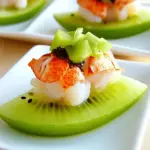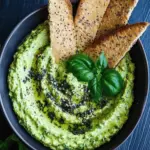These homemade coconut shrimp are a delightful combination of sweet and savory flavors, encased in a perfectly crispy coating. The light beer batter provides a delicate crunch, while the shredded coconut adds a tropical sweetness that pairs beautifully with the succulent shrimp inside.
Served with two complementary dipping sauces—a spicy-sweet curry sauce and a creamy ginger mayo—this dish offers a balanced flavor profile that will satisfy a variety of palates. Whether you’re hosting a party or enjoying a casual meal at home, these coconut shrimp are sure to impress.
Full Recipe
Ingredients:
For the Coconut Shrimp:
-
1 cup pilsner beer
-
1½ cups all-purpose flour
-
1½ teaspoons kosher salt
-
½ teaspoon garlic powder
-
¼ teaspoon cayenne pepper
-
1½ teaspoons baking powder
-
1 cup panko breadcrumbs
-
1 cup sweetened shredded coconut
-
Vegetable oil, for frying
-
1 pound large, tail-on raw shrimp, peeled and deveined
For the Curry Sauce:
-
¼ cup sweet chili sauce
-
½ cup apricot or orange marmalade
-
½ teaspoon red curry paste
For the Ginger Mayo:
-
¼ cup mayonnaise
-
⅓ cup sweet chili sauce
-
1 teaspoon grated fresh ginger
Directions:
-
Prepare the Shrimp: In a medium bowl, whisk together the beer, ¾ cup flour, ½ teaspoon salt, garlic powder, cayenne pepper, and baking powder until smooth. In a separate bowl, combine the panko breadcrumbs and shredded coconut. Place the remaining flour and salt in a third bowl.
-
Coat the Shrimp: Working one shrimp at a time, dredge it in the flour mixture, dip into the beer batter, allowing excess to drip off, then coat with the coconut-panko mixture, pressing gently to adhere.
-
Fry the Shrimp: Heat 2 inches of vegetable oil in a large pot or Dutch oven over medium-high heat until it reaches 325°F (use a deep-fry thermometer for accuracy). Carefully add 3 to 4 shrimp at a time to the hot oil, frying until golden brown, about 1 minute per side. Using a slotted spoon, transfer the shrimp to a paper-towel-lined plate to drain. Repeat with remaining shrimp.
-
Prepare the Curry Sauce: In a small bowl, whisk together the sweet chili sauce, apricot or orange marmalade, and red curry paste until smooth.
-
Prepare the Ginger Mayo: In another small bowl, whisk together the mayonnaise, sweet chili sauce, and grated ginger until well combined.
-
Serve: Arrange the fried shrimp on a serving platter and serve immediately with the curry sauce and ginger mayo on the side for dipping.
Prep Time: 15 minutes
Cooking Time: 15 minutes
Total Time: 30 minutes
Kcal: Approximately 1218 kcal per serving
Servings: 4 servings
The Irresistible Allure of Coconut Shrimp
Coconut shrimp is a dish that beautifully marries the savory succulence of seafood with the lightly sweet crunch of shredded coconut. It’s the kind of recipe that instantly transports your taste buds to a tropical escape, all without leaving your kitchen. This dish has gained widespread popularity in coastal cuisines and upscale seafood restaurants, but its magic lies in how easily it can be recreated at home with simple ingredients and foolproof technique.
Typically served as an appetizer, coconut shrimp can easily stand in as a main course with the right side dishes. It’s both luxurious and approachable, satisfying for gourmet palates while also being a crowd-pleaser at parties and family dinners.
A Fusion of Texture and Flavor
What makes coconut shrimp such a standout dish is its textural contrast. The shrimp is tender and juicy, offering a savory interior that’s perfectly complemented by the crunchy, golden-brown coating on the outside. The batter—a blend of beer, flour, and seasonings—ensures a light and airy texture, while the panko and sweetened shredded coconut create a beautifully crisp shell that crackles with each bite.
Flavor-wise, coconut shrimp sits at the intersection of sweet, salty, and slightly spicy. The coconut adds natural sweetness, which is balanced by the garlic, cayenne, and salt in the batter. When paired with dipping sauces like red curry apricot glaze or a gingery sweet chili mayo, the result is a mouthwatering fusion of flavors that stimulate every part of the palate.
Cultural Roots and Culinary Influence
Coconut shrimp is thought to have evolved from Caribbean and Southeast Asian culinary traditions, where coconut is a staple ingredient used in both savory and sweet dishes. In coastal regions, coconut and seafood naturally find their way onto the same plate, often in the form of stews, grilled dishes, and fried specialties.
As coconut shrimp made its way into Western kitchens, it became more refined and experimental—showing up as a fried appetizer in tiki-style menus, cruise ship buffets, and contemporary bistros. The current version we see today in recipes like this one highlights the global nature of food and how simple ingredients can come together to form something uniquely delightful.
Perfect Occasions to Serve Coconut Shrimp
Coconut shrimp shines on any occasion. Whether you’re planning a laid-back game night with friends, a holiday gathering, or an elegant summer dinner party, this dish fits right in. Its handheld nature makes it ideal for appetizers, while its rich flavors and presentation appeal to gourmet sensibilities.
What’s especially great is its versatility in plating—it can be served in baskets lined with parchment paper for a casual look, or arranged delicately with greens and citrus slices for something more upscale. Add a chilled cocktail or tropical fruit salad, and you’ve got a well-rounded meal that’s both refreshing and satisfying.
The Importance of Dipping Sauces
While coconut shrimp is delicious on its own, the right dipping sauce can elevate it to unforgettable. This particular recipe includes two: a red curry and marmalade sauce and a ginger-infused sweet chili mayo. Each offers a different flavor profile—one is warm and subtly spicy with fruity undertones, while the other is creamy, cooling, and zingy.
The variety in sauces means diners can mix and match or double-dip, making the eating experience more engaging. If you’re entertaining, offering multiple dipping options turns the dish into an interactive element of your meal that sparks conversation and praise from guests.
Tips for Making the Best Coconut Shrimp
To ensure your coconut shrimp turns out perfectly crispy and flavorful, there are a few key techniques to keep in mind. First, selecting large, tail-on shrimp adds both aesthetic appeal and ease of handling. The tails serve as natural “handles” for dipping and eating.
Second, the oil temperature matters significantly. Too hot and the coating will burn before the shrimp cook through; too cool and the shrimp will soak up too much oil and turn greasy. Maintaining a frying temperature around 325°F is optimal. Also, always fry in small batches to avoid crowding, which can cause the temperature to drop and result in soggy shrimp.
Lastly, don’t skip the resting stage after frying. A quick drain on a paper-towel-lined plate helps remove excess oil and keeps that coveted crispiness intact.
Pairing Coconut Shrimp with Sides and Drinks
If you’re serving coconut shrimp as a main dish, the right sides will complement and round out your meal. Consider options like jasmine rice, mango slaw, grilled pineapple, or even seasoned sweet potato fries. These pairings echo the tropical theme and balance the richness of the fried shrimp.
When it comes to drinks, tropical cocktails like piña coladas, mojitos, or ginger-lime mocktails enhance the experience. For a non-alcoholic route, coconut water with a splash of lime or iced hibiscus tea would work beautifully.
Why Homemade Always Wins
There’s no denying the convenience of ordering coconut shrimp at a restaurant, but making it at home offers several advantages. First, you have full control over the quality and freshness of ingredients. Second, you can tweak the flavor to suit your preferences—add more spice, adjust the sweetness, or experiment with alternative sauces.
Homemade coconut shrimp also tends to be more economical, especially if you’re serving a group. Plus, it brings the added satisfaction of preparing a restaurant-worthy dish in your own kitchen—a little labor of love that’s sure to impress anyone who takes a bite.
Conclusion: A Recipe Worth Repeating
Coconut shrimp is more than just a tasty appetizer—it’s a sensory experience that combines taste, texture, and presentation in perfect harmony. The golden, crispy exterior gives way to tender shrimp inside, and the contrasting dipping sauces elevate every bite.
Whether you’re new to frying or a seasoned home cook, this recipe is straightforward, rewarding, and sure to earn repeat requests. It’s the kind of dish that never goes out of style—nostalgic for some, novel for others, and delightful for all.
So the next time you’re planning your dinner menu or party spread, consider adding coconut shrimp to the mix. It’s quick, crowd-pleasing, and bursting with flavor—and it might just become your new go-to recipe.






